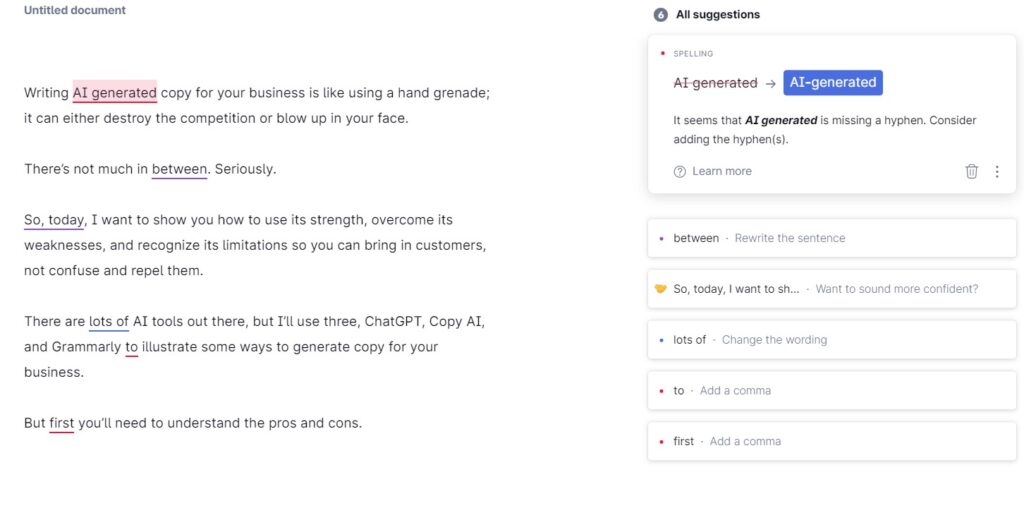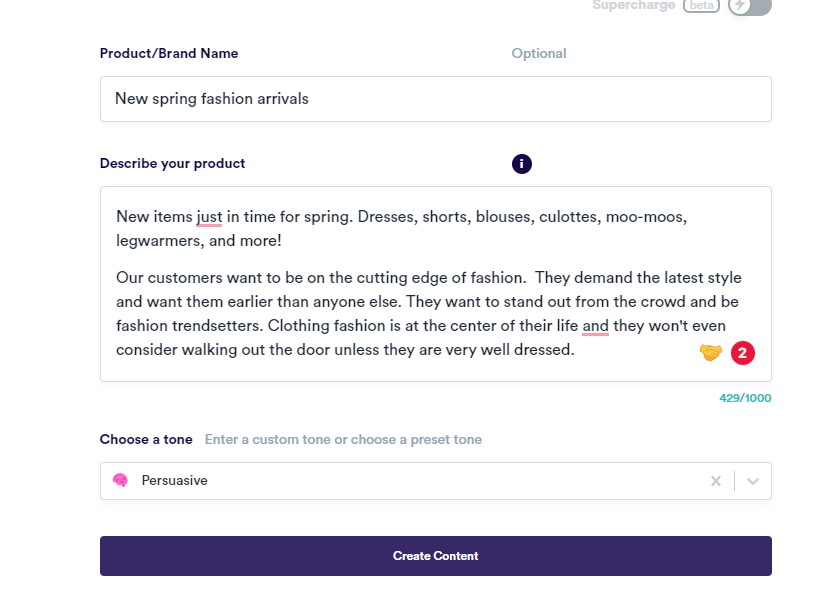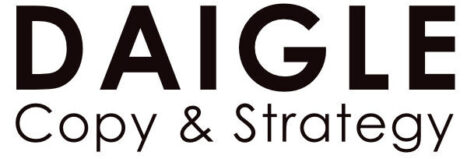
If you’re reading this, you’ve probably heard that AI-generated copy can write copy for your business.
The truth is it can help you start to write copy, but you’ll have to do the rest. In this post, we’ll take a look at how to use AI tools to generate copy ideas and even fix mistakes.
Then, I’ll walk you through an example of how to take these ideas and turn them into something that will get your ideal client to take action.
We’ll use two free AI tools, Grammarly and Copy AI, to demonstrate. You can practice with these at no cost, and they are reliable. I would have included ChatGPT over Copy AI, but it is often hard to access and will probably go to a paid model soon.
By the way, I have no affiliation with either tool.
But before we get started, here is a warning. A very serious warning
The dangers of using AI for copywriting
Writing AI-generated copy for your business is like using a hand grenade; it can either clear a path for success or blow up in your face.
There’s not much in between. Seriously. That’s a harsh analogy, but you need to understand the real dangers of misusing these tools.
And don’t be fooled by all the new “AI gurus” popping up.
A quick Google search of ChatGPT produces a harvest of gushing accolades by copywriters swearing it’s the best thing ever.
They say it will save your business, save your life, smooth out wrinkles, and make you dinner.
And their ultimate ChatGPT writing course is just what you need to produce copy like the pros!
Whatever, man.
But there is a grain of truth in their hyperbolic rants. Here it is.
AI can eliminate blank page syndrome
Suppose you need to write a sales email for your clothing boutique. You want to promote your new spring arrivals.
That email had better have a good subject line. Better yet, it should have a few that you can test.
If you don’t, no one will open your email. So it’s a lost opportunity. And lost revenue.
But writing subject lines that make people open is hard as hell. You might be staring at the blank screen, the cursor mocking you with its incessant blinking.
Here’s how to use AI to show Mr. Cursor two can play that game.
In Copy AI, select “Catchy Email Subject Lines,” put in your product, and describe it. Then choose your tone and hit create content, like in the example below.
Here’s what we get back:
New spring items just in time for spring.
New spring fashion arrivals! It’s all about color now…
There’s nothing like a new spring wardrobe!
Get in on the hottest spring trends before they’re gone!
There’s so many cute spring styles, why settle for one?
It even tells you the number of words and characters, so you stay within the 9-word, 60-character ideal formatting zone.
Of course, most of these subject lines suck. Some of them are just plain stupid.
New spring items just in time for spring. Really? When else would they arrive?
Others are boring and cliché’. There’s nothing like a spring wardrobe. Boring.
You still have to go back and rewrite a lot. If you don’t, you will lose sales.
But at least now, you aren’t staring at a blank page while nursing a mild panic attack. Now you have copy to improve. I’ll show you how to do that in a minute.
First, we’ll look at how AI can help you avoid mistakes in your copy.
Use AI to help make your copy readable and error free
This is one of my favorite uses for AI in writing. And one of my favorite tools is Grammarly.
It helps you avoid unnecessary words, avoid typos, and mechanical errors (extra commas, anyone?) and will even suggest sentence rewrites.
There are lots of others to try, like Hemingway, but Grammarly is the most comprehensive.
Here’s how the free version works:
Go to the site and click on New Document.
Set your goals in the popup box.
Upload your document, and Grammarly makes suggestions. Here’s an example from the first draft of this blog post.

Pretty cool but not foolproof.
It catches some errors but does not account for tone of voice. I want to be relaxed and conversational.
Grammarly wants me to turn in a college essay. But my readers aren’t college professors, so screw that.
And there have been many times when it missed mechanical errors. So, if I don’t go back and proof it myself, I can still come off sounding like a drunken third grader.
There might be a day when AI can write and edit copy as seamlessly as a human. I don’t know.
But I do know it can’t right now. That’s because it’s completely dependent on you putting in the best information possible.
And to do that, you’ll have to….
Research, research, research
Research will always be the great differentiator between average copy (like ChatGPT creates) and copy that moves customers to action.
So, know your customer’s pain points, fears, hopes, and why they buy products and services like yours.
How do you do that on a budget?
If you are a small business, you have an advantage. You have a personal relationship with your customer. So talk to them.
In-person retailers can simply hang out and listen. You’ll hear candid conversations about what they can’t find but want.
You’ll also see and hear when they are delighted by something they do find. Of course, when they are happy is the perfect time to pop in and ask questions.
“I’m so glad you like that! What do you like about it? What else can we offer that you’d like just as much?”
Not only does it give you invaluable information, it feels personal to them and builds customer loyalty. A double win!
If your business or service is internet based, surprise them with a stamped, handwritten thank you note and an offer for a discount if they take a small survey.
Attach a QR code to the note to reduce friction. Here’s a great guide on how to do that.
Handwritten notes are time consuming, but they are scalable, have a nearly 100% open rate, and are very unique. You’ll show you care, stand out from the crowd, and get valuable information. A triple win!
You can also read customer reviews from your business and others. They will reveal tons of pain points, concerns, wants, and desires that you can use for the next crucial step.
Give AI the correct input to produce better copy
Now that you have a better understanding of your customers, you can tell it to your AI copy generator.
Remember the boutique example? Our input wasn’t great because it included no customer research, only what the boutique offered.
Let’s put what our customers want into the input and see what happens.

Just a little customer information yields headlines like this.

Since one of your customers desires to stand out, this is a decent starting point for a subject line. It’s much better than what we generated before. But still not perfect.
But you can make it that way! Here’s how.
Editing AI copy
This subject line needs help on three fronts: word and character count, accuracy, and tone of voice.
It’s the perfect example because you can say that about most AI copy. So let’s figure out how to fix this line as an example.
First, it’s too wordy. As mentioned before, subject lines should be no more than nine words and 60 characters.
So, let’s drop “shiny.” It isn’t accurate unless all your clothes are glitter bombs.
Then we’ll drop fashion. If your customers subscribe to your emails, they’ll know what you are about.
Now it looks like this:
You need these spring arrivals to be the talk of the town.
Better. But still too long.
So, let’s change gears a bit. First, “talk of the town” is pretty cliché’ and old-fashioned. Our customer is cutting edge, remember?
They can’t be talked about if they are late to the party. So, establish a sense of urgency. That will imply that being early means grabbing attention.
With that in mind, a new subject line might look like this.
Get in early on new spring arrivals.
The words “early” and “new” tell your customer they will stand out from the crowd.
If you add the customer’s name to the front, it personalizes and raises open rates even higher.
And you’ll still be within the proper word and character count.
None of this would have happened just using AI. Instead, you would wind up with a subject line most people ignore.
Your email never gets read, and your product doesn’t move.
Putting it all together
I get it. Good copywriters are expensive, and you need to save money.
And AI can be a big help.
But you will have to do the research, provide good input, and edit heavily. And keep learning about copywriting, too. There are a ton of good books out there, depending on your level of understanding.
My favorite recommendation for beginners is The Copywriter’s Handbook, 4th edition, by Bob Bly. It’s very comprehensive, and you can use it as a reference guide.
I hope this article helped. If it did, please let me know why so I can keep delivering the goods.
If it didn’t, just be quiet. I’m kidding. Please let me know what’s broken, so I don’t bang you over the head with more meaningless drivel.
Thanks, and best of luck!

